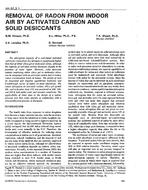Description
The adsorption capacity of a coal-based activated carbon for radon from dry nitrogen is significantly higher than that of either silica gel or molecular sieves, although the capacity of activated carbon decreases sharply in the presence of water vapour. However, solid desiccant systems employing either silica gel or molecular sieves can be integrated with an activated carbon bed to reduce radon concentration levels in homes. The design of such an integrated unit requires equilibrium isotherms and breakthrough curves of radon on these adsorbents. The radon adsorption on activated carbon, silica gel (grade 40), and molecular sieve-13X was measured at 288, 298, and 308 K both under static and dynamic conditions. The applicability of these data to the design of a radon-removal unit that could operate in conjunction with a dehumidification process is discussed.
KEYWORDS: radon, air cleaning, air pollution, desiccants, indoor, activated carbon, housing, domestic, content, designing, equilibrium, adsorbents, measuring, dehumidifiers
Citation: ASHRAE Trans. 1992, vol.98, Part 1, Paper number AN-92-3-1, 699-703, 7 figs., 1 tab., 8 refs.
Product Details
- Published:
- 1992
- File Size:
- 1 file , 610 KB
- Product Code(s):
- D-17922




